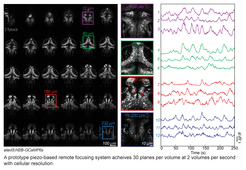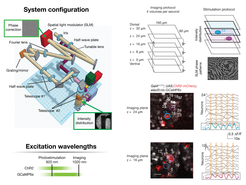Technologies for circuit interrogation
We develop and implement optical and computational approaches for detailed circuit investigation, with a particular focus on two-photon imaging and optogenetics. Transgenic fish expressing genetically encoded fluorescent indicators in the brain allow us to visualize neuron activity in a behaving vertebrate. Imaging can be combined with optogenetic actuators to provide precise manipulations enabling us to test and validate hypotheses of circuit mechanisms.
Optical, genetic and computational methods for circuit analysis

Answering complex questions about how circuits process sensory information and generate behavior requires innovative approaches and new technologies, both to generate data as well as to analyze and interpret them. Within our department we have several ongoing projects for improving functional calcium imaging, selective manipulation of circuit activities, and analysis and modeling.
Rapid two-photon volumetric imaging
Two-photon calcium imaging is a popular approach in the lab, and pairs well with the genetic and optical access offered by zebrafish larvae. We routinely record functional activity from a large number of neurons together with sensory stimuli and behavioral tracking. Standard two-photon microscopes image a single plane at a time, however brains and circuits of interest are three-dimensional. Therefore, we are developing multiplane imaging techniques to rapidly acquire 3D functional volumes.
Holographic light shaping for optogenetics
Imaging is a powerful approach, but causal understanding and validation of circuit models requires manipulation. Optogenetics offers a toolbox to meet this need, allowing light to control neuron activity. We have been applying optogenetics for many years, with more recent efforts focusing on increased photostimulation precision to target individual neurons. Using two-photon holographic wave-front shaping, we use 3D light patterns to selectively drive activity in multiple neurons in any desired spatial or temporal pattern.

For more details see dal Maschio and Donovan et al.
Continuing efforts focus on improving this approach, via both engineering of optical systems and computational methods that can optimally guide this selective photostimulation.
Analysis and computational modeling
Done right, analysis is not just a black box that gives you a p-value, but rather should shape your experiments and give quantitative form to your hypotheses. Together with other lab members, we analyze high-dimensional data, especially from behavior and functional circuit investigation. Machine learning offers a powerful framework for structuring question, using unsupervised clustering, supervised classifiers, or regression analyses.
Another area of interest is in computational methods to guide photostimulation for principled circuit investigation. The stimulation precision granted by two-photon holography creates a large number of possible activation patterns, which is far too large to randomly explore. Using simulation, we have started developing more effective strategies for investigating effective functional connectivity and understanding how individual neurons contribute to network activity.

